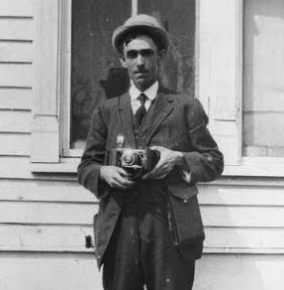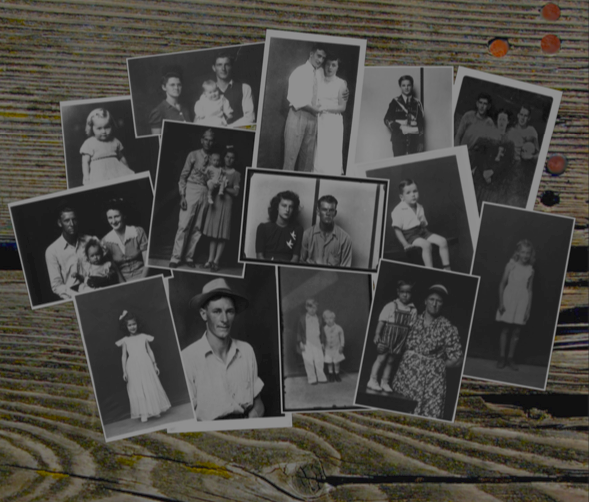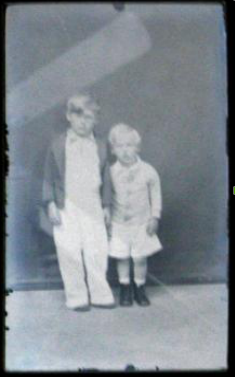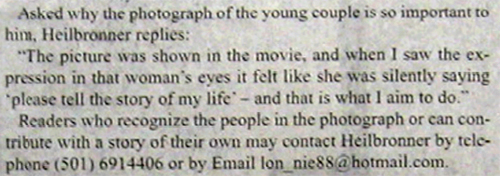According to a Chinese proverb a man should accomplish three things during his lifetime: plant a tree, father a son, and write a book.
The first chore should be an easy one, provided you find an appropriate place for the sapling – in Lonnie's case that wasn't a problem, since he owned a tiny piece of property just wide enough to make a sheltered home for a small Swedish fir.
In order to put a child into this world all you have to do is follow the advice: “Let Old Mother Nature Have Her Way” - which happens to be the title of a hit recording by country singer Carl Smith. For Lonnie and his wife the fifty-fifty chance of having a male child worked in favor of the proverb – baby boy Mark was the first-born, soon to be followed by sister Corinna.
The third task - writing a book – required both more effort and more time than the other two: You have to find a topic that will inspire and motivate you and, where facts are concerned, you will have to spend many hours and days on meticulous research as a foundation for what you want to convey.
The book in question, titled “It Hasn't Always Been Easy”, is the result of a spontaneous decision Lonnie made after watching a documentary about photographer Mike Disfarmer, an Arkansas resident of German descent. He had a small studio in Heber Springs, where he made a living taking pictures of his fellow citizens.

He had a camera that used glass negatives, which were regarded as outdated in the Forties and Fifties. But it was just this obsolete technique that made Disfarmer posthumously famous, when some of those plates found their way into stylish New York photo galleries. Photo buffs were delighted, and in the ensuing bonanza prices for Disfarmer portraits rose to incredible heights.
But strangely enough almost nobody seemed to be interested in the people shown in these pictures. Lonnie remembers: “I felt that this was unfair and that these silent people should be given the opportunity to tell their life stories to the world. That meant I had to go to Arkansas and try to find some of the portrayed persons who would be willing to contribute to my project.” Lonnie's friends and colleagues were skeptical, but that did not discourage him. He took the trip and returned a month later with forty hours of recorded interviews. Fifteen people shared their memories with him – more than what he had hoped for.
Which brings us back to Old Mother Nature: Louie Clark, co-author of that number-one-song mentioned above, was photographed by Disfarmer in the Forties and, since he agreed to talk about his life, appears in the book with a chapter of his own.

Get a first impression of that book right here and now. You will shortly be able to download the entire 260 pages as a so-called e-Book, at a fee about half the price of the printed version. There is another advantage: This e-Book is a multimedia product that also contains sound files – featuring both a number of songs and excerpts from the recorded narratives.
So here goes:
... I had a little trouble finding the Flowers place, as it turned out that the map in my GPS device obviously had not been updated lately, so I inadvertently overshot my target and had to make a U-turn at a stretch of the two-lane road where I could see far enough both ways to make the maneuver – you don't want to be surprised by a speeding eighteen-wheeler while blocking the road sideways.
Like so many of the countryside residences the house was right beside the highway, in this case close to the southern county line. I was greeted by Mr. Flowers and his wife Joan, who was to contribute to my project together with Kelsie with quite a few of her own memories.
The front room gave the impression that all the furniture had come straight out of a Montgomery Ward catalogue from a few decades back. We sat facing each other at a table of dark polished wood, and, after clearing his throat, Mr. Flowers began:

Kelsie Flowers with brother Don
“I was born and raised two miles southwest of Quitman by highway 25. We lived across from a little church. When I was seven we moved. A short time later the house burned down. My uncle ran a service station in town and he had a little farm. When I grew a little older I worked for him at the service station. I was the oldest and I helped Dad with his work and some of my mom's. At nine I got to plow with a team of horses. Which was a job for a grown man. I grew up the hard way. We didn't have a whole lot. We had an old car, a Model A, which was what I learned to drive on.”
Mr. Flowers mentioned another aspect of their country life: “The gas people have just finished drilling for natural gas in this area, but they say that now, when the gas has been pumped out from what they call tables - different layers - there is oil underneath, so they will be back. As long as they drilled all wildlife around here vanished. But now the deer are gradually coming back. The other day a herd crossed the road close to the house – there were at least thirty of them.”
From Glass Negative To Digital Multi-Media
One of the chapters in Lonnie's book is dedicated to a couple whose identity remains a mystery. Lonnie remembers:
"After watching the Disfarmer documentary on Swedish TV, it was especially one of the photographs shown in the program that fueled my decision to take the trip to Arkansas. But well there, I failed to find just that couple. So I decided to seek the help of the local newspaper, the “Sun-Times”, in searching for the two:


The article caused some useful reactions by readers, but unfortunately, it did not produce any clues as to the couple's identity. One gentleman told me: 'You should have come a little earlier, because you could have met the lady who had delivered mail throughout the county for half a century. She knew each and every citizen, but she passed away last month.'
Short of the result I had hoped for, I included the photograph in my book with a chapter titled “The Mystery Couple”. And since I still felt I owed something special to the young lady I wrote a song woven around her fictitious life, appropriately named “I Wish I Had Your Photograph”. Eventually, my good friend Pete Lojewski encouraged me to illustrate that little southern tune with a video – so here goes:”
https://www.youtube.com/watch?v=yLBiNPexHfM
By the way: As a book author, Lonnie replaced his first name with Claude, which is derived from Latin, meaning “He who perseveres”, a kind of tribute to the descendants of the American pioneers portrayed in the book. It is also the international version of Lonnie's original Christian name Klaus.